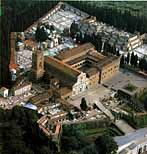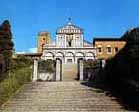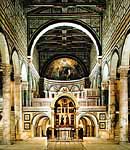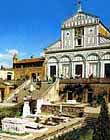
View from the air
It was constructed sometime after the year 1000 on top of a pre-existent
Oratory that had been built by St. Miniato, the first evangelizer and Christian
martyr in Florence. Victim of the persecutions of the Emperor Decius (249-251
A.D.), Miniato is thought to have been an Armenian prince: the legend narrates
that, after his decapitation, he picked up his head, put it back on his
neck and went to die in a cave on Monte alle Croci, where he had lived as
a hermit and where later the oratory and the church that bear his name were
to be built.
Construction on the temple, one of the finest examples of pure Florentine Romanesque
architecture, first started in 1018, thanks to Bishop Ildebrando, and continued
until 1207. The facade was carried out in white Carrara and green Prato marble
(12th-13th centuries) and divided into two orders linked together by rhombiform
inlaid work, in allusion to the
"opus reticolatum", the typical system used during the
Roman Empire for building walls; it was also used by Leon Battista Alberti for the base of Palazzo Rucellai.

Front View
The upper order is surmounted by a 13th century mosaic of the enthroned
Christ in benediction between the Madonna and St. Miniato painted on a gilded
background. The huge gilded copper eagle above it, placed on top of the
pediment, is a symbol of the Arte di Calimala,
which administered the wealth of the Benedictine convent from 1288.
The spectacular facade of San Miniato was to inspire Alberti's completion of the
facade of Santa Maria Novella in the 15th century and the covering of the facades
of the Duomo and Santa Croce in the 19th century.
The brilliant play of light that is created when the sun shines on the exterior
of the monument, as well as that to be found in the interior of the apse, are
alone enough to make it well worth while making this short trip outside the city
centre.
Palazzo dei Vescovi or the Bishops' Palace stands on the right, looking at the
church; it can be visited by ringing at the door inside the church and is
today inhabited by Olivetan monks, who also take care of the basilica.
Remains of the ancient ramparts, with the bell tower built by Baccio
d'Agnolo (1518), which looks almost like a fragment of some Roman fortification,
stand on the left. This belltower, built to replace the original one, which fell
down in 1499, was never completed;
instead it was used for military purposes during the siege of 1529
at the suggestion of Michelangelo. Protected by mattresses and bales
of wool, it was used as a base for the two cannon that were supposed
to fire on the troups of Charles V. It still bears signs of the use
it was put to today.

Nave and altar
The interior (where additions were carried out up until Baroque times)
is divided into three naves, with a beautiful inlaid marble floor decorated
with the Symbols of the Zodiac (11th century) in the centre. The raised
Presbitery is formed by a rare Tuscan-Romanesque sculptoral complex of classical
inspiration: the altar, enclosed by a marble transenna (1207), the square
pulpit (the work of Giovanni di Gaiole and Francesco di Domenico) and the
lectern, supported by the eagle of St. John the Evangelist. The Choir contains
a mosaic of the enthroned Christ in benediction (1297, restored by Alessio
Baldovinetti in 1491).
The crypt (11th century) is situated underneath the Presbitery;
it is supported by 36 agile columns of various origin and the ceiling
is frescoed with Saints and Prophets by Taddeo Gaddi. The remains
of St. Miniato were placed here in 1013. The beautiful and refined
Chapel of the Crucifix stands in front of it, in the centre of the
main aisle; this is a Renaissance marble shrine that Michelozzo was commissioned to carry out (1448)
by Piero dei Medici to contain the
so-called St. Giovanni Gualberto Crucifix, which was greatly venerated
and is now in Santa Trinita: there are terracottas by Luca
della Robbia on the barrel vaults and a panel by Agnolo Gaddi
above the altar.
Apart from several 14th and 15th century frescoes, the righthand nave contains
the remains of St. Miniato, an altar with a cuspidate panel, the masterpiece
of Jacopo del Casentino, and the entrance to the Sacristy, frescoed by Spinello Aretino with Stories of St. Benedict (1387
c. much restored in 1840), possibly this artist's most important work.
The Renaissance Chapel of the Cardinal of Portugal (1461-66) in the lefthand
nave was built by Brunelleschi's pupil Antonio
Manetti for Jacopo di Lusitania, the Cardinal Archbishop of Lisbon, who died
in Florence in 1459. The five medallions on the ceiling are by Luca
della Robbia, while the chapel itself contains a fresco of the Annunciation
by Alessio Baldovinetti (1466-67), a panel (whose original is in the Uffizi)
and frescoes of Angels in flight by Antonio e Piero
del Pollaiolo. The marble funeral monument was carved by Antonio Rossellino.
A contribution by the great artist Paolo Uccello can
be found in the cloister: remains of the frescoes of Scenes from the lives of
the Holy Fathers (1440 c.), painted in the upper loggia.

The Monumental Cemetery
The Monumental Cemetery (known as "of the Holy Gates") outside the Basilica is also well worth a visit; it was carried out in the last century in the conventual area, inside the fortified enclosure created by Michelangelo in 1529. Designed by architect Nicolò Matas during the period in which he was working on the facade of Santa Croce, it contains the remains of many celebrities like Papini, Montale, Stibbert, Villari and Lorenzini (known as "il Collodi", the creator of Pinocchio). The various family chapels belonging to the Florentine bourgeoisie can be said to represent a real repertoire of the city architecture of the time: Liberty, Art Deco, Rationalism and organic architecture.
